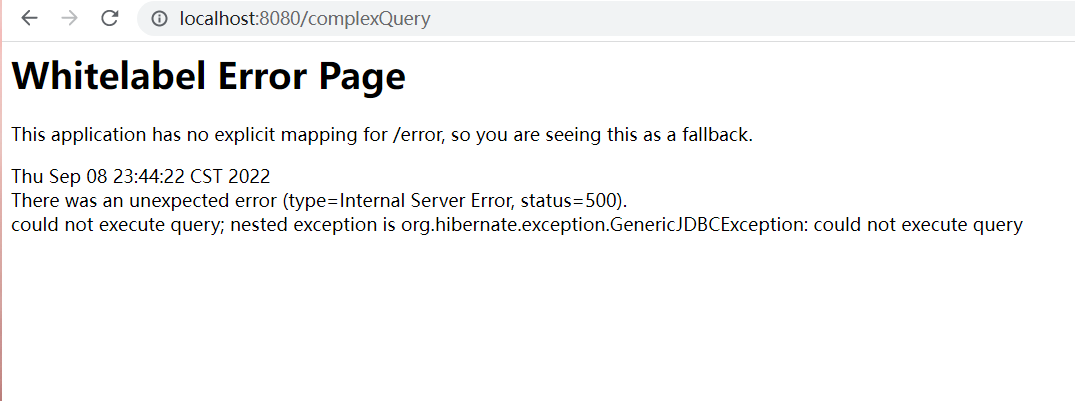一個註解解決ShardingJdbc不支援複雜SQL
2022-09-09 15:00:57
背景介紹
公司最近做分庫分表業務,接入了 Sharding JDBC,接入完成後,迴歸測試時發現好幾個 SQL 執行報錯,關鍵這幾個表都還不是分片表。報錯如下:

這下糟了嘛。熟悉 Sharding JDBC 的同學應該知道,有很多 SQL 它是不支援的。官方截圖如下:

如果要去修改這些複雜 SQL 的話,可能要花費很多時間。那怎麼辦呢?只能從 Sharding JDBC 這裡找突破口了,兩天的研究,出來了下面這個只需要加一個註解輕鬆解決 Sharding Jdbc 不支援複雜 SQL 的方案。
問題復現
我本地寫了一個複雜 SQL 進行測試:
public List<Map<String, Object>> queryOrder(){
List<Map<String, Object>> orders = borderRepository.findOrders();
return orders;
}
public interface BOrderRepository extends JpaRepository<BOrder,Long> {
@Query(value = "SELECT * FROM (SELECT id,CASE WHEN company_id =1 THEN '小' WHEN company_id=4 THEN '中' ELSE '大' END AS com,user_id as userId FROM b_order0) t WHERE t.com ='中'",nativeQuery =true)
List<Map<String, Object>> findOrders();
}
寫了個測試 controller 來呼叫,呼叫後果然報錯了。

解決思路
因為查詢的複雜 SQL 的表不是分片表,那能不能指定這幾個複雜查詢的時候不用 Sharding JDBC 的資料來源呢?
- 在注入 Sharding JDBC 資料來源的地方做處理,注入一個我們自定義的資料來源
- 這樣我們獲取連線的時候就能返回原生資料來源了
- 另外我們宣告一個註解,對標識了註解的就返回原生資料來源,否則還是返回 Sharding 資料來源
具體實現
- 編寫一個 autoConfig 類,來替換 ShardingSphereAutoConfiguration 類
/**
* 動態資料來源核心自動設定類
*
*
*/
@Configuration
@ComponentScan("org.apache.shardingsphere.spring.boot.converter")
@EnableConfigurationProperties(SpringBootPropertiesConfiguration.class)
@ConditionalOnProperty(prefix = "spring.shardingsphere", name = "enabled", havingValue = "true", matchIfMissing = true)
@AutoConfigureBefore(DataSourceAutoConfiguration.class)
public class DynamicDataSourceAutoConfiguration implements EnvironmentAware {
private String databaseName;
private final SpringBootPropertiesConfiguration props;
private final Map<String, DataSource> dataSourceMap = new LinkedHashMap<>();
public DynamicDataSourceAutoConfiguration(SpringBootPropertiesConfiguration props) {
this.props = props;
}
/**
* Get mode configuration.
*
* @return mode configuration
*/
@Bean
public ModeConfiguration modeConfiguration() {
return null == props.getMode() ? null : new ModeConfigurationYamlSwapper().swapToObject(props.getMode());
}
/**
* Get ShardingSphere data source bean.
*
* @param rules rules configuration
* @param modeConfig mode configuration
* @return data source bean
* @throws SQLException SQL exception
*/
@Bean
@Conditional(LocalRulesCondition.class)
@Autowired(required = false)
public DataSource shardingSphereDataSource(final ObjectProvider<List<RuleConfiguration>> rules, final ObjectProvider<ModeConfiguration> modeConfig) throws SQLException {
Collection<RuleConfiguration> ruleConfigs = Optional.ofNullable(rules.getIfAvailable()).orElseGet(Collections::emptyList);
DataSource dataSource = ShardingSphereDataSourceFactory.createDataSource(databaseName, modeConfig.getIfAvailable(), dataSourceMap, ruleConfigs, props.getProps());
return new WrapShardingDataSource((ShardingSphereDataSource) dataSource,dataSourceMap);
}
/**
* Get data source bean from registry center.
*
* @param modeConfig mode configuration
* @return data source bean
* @throws SQLException SQL exception
*/
@Bean
@ConditionalOnMissingBean(DataSource.class)
public DataSource dataSource(final ModeConfiguration modeConfig) throws SQLException {
DataSource dataSource = !dataSourceMap.isEmpty() ? ShardingSphereDataSourceFactory.createDataSource(databaseName, modeConfig, dataSourceMap, Collections.emptyList(), props.getProps())
: ShardingSphereDataSourceFactory.createDataSource(databaseName, modeConfig);
return new WrapShardingDataSource((ShardingSphereDataSource) dataSource,dataSourceMap);
}
/**
* Create transaction type scanner.
*
* @return transaction type scanner
*/
@Bean
public TransactionTypeScanner transactionTypeScanner() {
return new TransactionTypeScanner();
}
@Override
public final void setEnvironment(final Environment environment) {
dataSourceMap.putAll(DataSourceMapSetter.getDataSourceMap(environment));
databaseName = DatabaseNameSetter.getDatabaseName(environment);
}
@Role(BeanDefinition.ROLE_INFRASTRUCTURE)
@Bean
@ConditionalOnProperty(prefix = "spring.datasource.dynamic.aop", name = "enabled", havingValue = "true", matchIfMissing = true)
public Advisor dynamicDatasourceAnnotationAdvisor() {
DynamicDataSourceAnnotationInterceptor interceptor = new DynamicDataSourceAnnotationInterceptor(true);
DynamicDataSourceAnnotationAdvisor advisor = new DynamicDataSourceAnnotationAdvisor(interceptor, DS.class);
return advisor;
}
}
- 自定義資料來源
public class WrapShardingDataSource extends AbstractDataSourceAdapter implements AutoCloseable{
private ShardingSphereDataSource dataSource;
private Map<String, DataSource> dataSourceMap;
public WrapShardingDataSource(ShardingSphereDataSource dataSource, Map<String, DataSource> dataSourceMap) {
this.dataSource = dataSource;
this.dataSourceMap = dataSourceMap;
}
public DataSource getTargetDataSource(){
String peek = DynamicDataSourceContextHolder.peek();
if(StringUtils.isEmpty(peek)){
return dataSource;
}
return dataSourceMap.get(peek);
}
@Override
public Connection getConnection() throws SQLException {
return getTargetDataSource().getConnection();
}
@Override
public Connection getConnection(final String username, final String password) throws SQLException {
return getConnection();
}
@Override
public void close() throws Exception {
DataSource targetDataSource = getTargetDataSource();
if (targetDataSource instanceof AutoCloseable) {
((AutoCloseable) targetDataSource).close();
}
}
@Override
public int getLoginTimeout() throws SQLException {
DataSource targetDataSource = getTargetDataSource();
return targetDataSource ==null ? 0 : targetDataSource.getLoginTimeout();
}
@Override
public void setLoginTimeout(final int seconds) throws SQLException {
DataSource targetDataSource = getTargetDataSource();
targetDataSource.setLoginTimeout(seconds);
}
}
- 宣告指定資料來源註解
@Target({ElementType.TYPE, ElementType.METHOD})
@Retention(RetentionPolicy.RUNTIME)
@Documented
public @interface DS {
/**
* 資料來源名
*/
String value();
}
- 另外使用 AOP 的方式攔截使用了註解的類或方法,並且要將這些用了註解的方法存起來,在獲取資料來源連線的時候取出來進行判斷。這就還要用到 ThreadLocal。
aop 攔截器:
public class DynamicDataSourceAnnotationInterceptor implements MethodInterceptor {
private final DataSourceClassResolver dataSourceClassResolver;
public DynamicDataSourceAnnotationInterceptor(Boolean allowedPublicOnly) {
dataSourceClassResolver = new DataSourceClassResolver(allowedPublicOnly);
}
@Override
public Object invoke(MethodInvocation invocation) throws Throwable {
String dsKey = determineDatasourceKey(invocation);
DynamicDataSourceContextHolder.push(dsKey);
try {
return invocation.proceed();
} finally {
DynamicDataSourceContextHolder.poll();
}
}
private String determineDatasourceKey(MethodInvocation invocation) {
String key = dataSourceClassResolver.findKey(invocation.getMethod(), invocation.getThis());
return key;
}
}
aop 切面定義:
/**
* aop Advisor
*/
public class DynamicDataSourceAnnotationAdvisor extends AbstractPointcutAdvisor implements BeanFactoryAware {
private final Advice advice;
private final Pointcut pointcut;
private final Class<? extends Annotation> annotation;
public DynamicDataSourceAnnotationAdvisor(MethodInterceptor advice,
Class<? extends Annotation> annotation) {
this.advice = advice;
this.annotation = annotation;
this.pointcut = buildPointcut();
}
@Override
public Pointcut getPointcut() {
return this.pointcut;
}
@Override
public Advice getAdvice() {
return this.advice;
}
@Override
public void setBeanFactory(BeanFactory beanFactory) throws BeansException {
if (this.advice instanceof BeanFactoryAware) {
((BeanFactoryAware) this.advice).setBeanFactory(beanFactory);
}
}
private Pointcut buildPointcut() {
Pointcut cpc = new AnnotationMatchingPointcut(annotation, true);
Pointcut mpc = new AnnotationMethodPoint(annotation);
return new ComposablePointcut(cpc).union(mpc);
}
/**
* In order to be compatible with the spring lower than 5.0
*/
private static class AnnotationMethodPoint implements Pointcut {
private final Class<? extends Annotation> annotationType;
public AnnotationMethodPoint(Class<? extends Annotation> annotationType) {
Assert.notNull(annotationType, "Annotation type must not be null");
this.annotationType = annotationType;
}
@Override
public ClassFilter getClassFilter() {
return ClassFilter.TRUE;
}
@Override
public MethodMatcher getMethodMatcher() {
return new AnnotationMethodMatcher(annotationType);
}
private static class AnnotationMethodMatcher extends StaticMethodMatcher {
private final Class<? extends Annotation> annotationType;
public AnnotationMethodMatcher(Class<? extends Annotation> annotationType) {
this.annotationType = annotationType;
}
@Override
public boolean matches(Method method, Class<?> targetClass) {
if (matchesMethod(method)) {
return true;
}
// Proxy classes never have annotations on their redeclared methods.
if (Proxy.isProxyClass(targetClass)) {
return false;
}
// The method may be on an interface, so let's check on the target class as well.
Method specificMethod = AopUtils.getMostSpecificMethod(method, targetClass);
return (specificMethod != method && matchesMethod(specificMethod));
}
private boolean matchesMethod(Method method) {
return AnnotatedElementUtils.hasAnnotation(method, this.annotationType);
}
}
}
}
/**
* 資料來源解析器
*
*/
public class DataSourceClassResolver {
private static boolean mpEnabled = false;
private static Field mapperInterfaceField;
static {
Class<?> proxyClass = null;
try {
proxyClass = Class.forName("com.baomidou.mybatisplus.core.override.MybatisMapperProxy");
} catch (ClassNotFoundException e1) {
try {
proxyClass = Class.forName("com.baomidou.mybatisplus.core.override.PageMapperProxy");
} catch (ClassNotFoundException e2) {
try {
proxyClass = Class.forName("org.apache.ibatis.binding.MapperProxy");
} catch (ClassNotFoundException ignored) {
}
}
}
if (proxyClass != null) {
try {
mapperInterfaceField = proxyClass.getDeclaredField("mapperInterface");
mapperInterfaceField.setAccessible(true);
mpEnabled = true;
} catch (NoSuchFieldException e) {
e.printStackTrace();
}
}
}
/**
* 快取方法對應的資料來源
*/
private final Map<Object, String> dsCache = new ConcurrentHashMap<>();
private final boolean allowedPublicOnly;
/**
* 加入擴充套件, 給外部一個修改aop條件的機會
*
* @param allowedPublicOnly 只允許公共的方法, 預設為true
*/
public DataSourceClassResolver(boolean allowedPublicOnly) {
this.allowedPublicOnly = allowedPublicOnly;
}
/**
* 從快取獲取資料
*
* @param method 方法
* @param targetObject 目標物件
* @return ds
*/
public String findKey(Method method, Object targetObject) {
if (method.getDeclaringClass() == Object.class) {
return "";
}
Object cacheKey = new MethodClassKey(method, targetObject.getClass());
String ds = this.dsCache.get(cacheKey);
if (ds == null) {
ds = computeDatasource(method, targetObject);
if (ds == null) {
ds = "";
}
this.dsCache.put(cacheKey, ds);
}
return ds;
}
/**
* 查詢註解的順序
* 1. 當前方法
* 2. 橋接方法
* 3. 當前類開始一直找到Object
* 4. 支援mybatis-plus, mybatis-spring
*
* @param method 方法
* @param targetObject 目標物件
* @return ds
*/
private String computeDatasource(Method method, Object targetObject) {
if (allowedPublicOnly && !Modifier.isPublic(method.getModifiers())) {
return null;
}
//1. 從當前方法介面中獲取
String dsAttr = findDataSourceAttribute(method);
if (dsAttr != null) {
return dsAttr;
}
Class<?> targetClass = targetObject.getClass();
Class<?> userClass = ClassUtils.getUserClass(targetClass);
// JDK代理時, 獲取實現類的方法宣告. method: 介面的方法, specificMethod: 實現類方法
Method specificMethod = ClassUtils.getMostSpecificMethod(method, userClass);
specificMethod = BridgeMethodResolver.findBridgedMethod(specificMethod);
//2. 從橋接方法查詢
dsAttr = findDataSourceAttribute(specificMethod);
if (dsAttr != null) {
return dsAttr;
}
// 從當前方法宣告的類查詢
dsAttr = findDataSourceAttribute(userClass);
if (dsAttr != null && ClassUtils.isUserLevelMethod(method)) {
return dsAttr;
}
//since 3.4.1 從介面查詢,只取第一個找到的
for (Class<?> interfaceClazz : ClassUtils.getAllInterfacesForClassAsSet(userClass)) {
dsAttr = findDataSourceAttribute(interfaceClazz);
if (dsAttr != null) {
return dsAttr;
}
}
// 如果存在橋接方法
if (specificMethod != method) {
// 從橋接方法查詢
dsAttr = findDataSourceAttribute(method);
if (dsAttr != null) {
return dsAttr;
}
// 從橋接方法宣告的類查詢
dsAttr = findDataSourceAttribute(method.getDeclaringClass());
if (dsAttr != null && ClassUtils.isUserLevelMethod(method)) {
return dsAttr;
}
}
return getDefaultDataSourceAttr(targetObject);
}
/**
* 預設的獲取資料來源名稱方式
*
* @param targetObject 目標物件
* @return ds
*/
private String getDefaultDataSourceAttr(Object targetObject) {
Class<?> targetClass = targetObject.getClass();
// 如果不是代理類, 從當前類開始, 不斷的找父類別的宣告
if (!Proxy.isProxyClass(targetClass)) {
Class<?> currentClass = targetClass;
while (currentClass != Object.class) {
String datasourceAttr = findDataSourceAttribute(currentClass);
if (datasourceAttr != null) {
return datasourceAttr;
}
currentClass = currentClass.getSuperclass();
}
}
// mybatis-plus, mybatis-spring 的獲取方式
if (mpEnabled) {
final Class<?> clazz = getMapperInterfaceClass(targetObject);
if (clazz != null) {
String datasourceAttr = findDataSourceAttribute(clazz);
if (datasourceAttr != null) {
return datasourceAttr;
}
// 嘗試從其父介面獲取
return findDataSourceAttribute(clazz.getSuperclass());
}
}
return null;
}
/**
* 用於處理巢狀代理
*
* @param target JDK 代理類物件
* @return InvocationHandler 的 Class
*/
private Class<?> getMapperInterfaceClass(Object target) {
Object current = target;
while (Proxy.isProxyClass(current.getClass())) {
Object currentRefObject = AopProxyUtils.getSingletonTarget(current);
if (currentRefObject == null) {
break;
}
current = currentRefObject;
}
try {
if (Proxy.isProxyClass(current.getClass())) {
return (Class<?>) mapperInterfaceField.get(Proxy.getInvocationHandler(current));
}
} catch (IllegalAccessException ignore) {
}
return null;
}
/**
* 通過 AnnotatedElement 查詢標記的註解, 對映為 DatasourceHolder
*
* @param ae AnnotatedElement
* @return 資料來源對映持有者
*/
private String findDataSourceAttribute(AnnotatedElement ae) {
AnnotationAttributes attributes = AnnotatedElementUtils.getMergedAnnotationAttributes(ae, DS.class);
if (attributes != null) {
return attributes.getString("value");
}
return null;
}
}
ThreadLocal:
public final class DynamicDataSourceContextHolder {
/**
* 為什麼要用連結串列儲存(準確的是棧)
* <pre>
* 為了支援巢狀切換,如ABC三個service都是不同的資料來源
* 其中A的某個業務要調B的方法,B的方法需要呼叫C的方法。一級一級呼叫切換,形成了鏈。
* 傳統的只設定當前執行緒的方式不能滿足此業務需求,必須使用棧,後進先出。
* </pre>
*/
private static final ThreadLocal<Deque<String>> LOOKUP_KEY_HOLDER = new NamedThreadLocal<Deque<String>>("dynamic-datasource") {
@Override
protected Deque<String> initialValue() {
return new ArrayDeque<>();
}
};
private DynamicDataSourceContextHolder() {
}
/**
* 獲得當前執行緒資料來源
*
* @return 資料來源名稱
*/
public static String peek() {
return LOOKUP_KEY_HOLDER.get().peek();
}
/**
* 設定當前執行緒資料來源
* <p>
* 如非必要不要手動呼叫,呼叫後確保最終清除
* </p>
*
* @param ds 資料來源名稱
*/
public static String push(String ds) {
String dataSourceStr = StringUtils.isEmpty(ds) ? "" : ds;
LOOKUP_KEY_HOLDER.get().push(dataSourceStr);
return dataSourceStr;
}
/**
* 清空當前執行緒資料來源
* <p>
* 如果當前執行緒是連續切換資料來源 只會移除掉當前執行緒的資料來源名稱
* </p>
*/
public static void poll() {
Deque<String> deque = LOOKUP_KEY_HOLDER.get();
deque.poll();
if (deque.isEmpty()) {
LOOKUP_KEY_HOLDER.remove();
}
}
/**
* 強制清空本地執行緒
* <p>
* 防止記憶體漏失,如手動呼叫了push可呼叫此方法確保清除
* </p>
*/
public static void clear() {
LOOKUP_KEY_HOLDER.remove();
}
}
- 啟動類上做如下設定:
引入我們寫的自動設定類,排除 ShardingJdbc 的自動設定類。
@SpringBootApplication(exclude = ShardingSphereAutoConfiguration.class)
@Import({DynamicDataSourceAutoConfiguration.class})
public class ShardingRunApplication {
public static void main(String[] args) {
SpringApplication.run(ShardingRunApplication.class);
}
}
最後,我們給之前寫的 Repository 加上註解:
public interface BOrderRepository extends JpaRepository<BOrder,Long> {
@DS("slave0")
@Query(value = "SELECT * FROM (SELECT id,CASE WHEN company_id =1 THEN '小' WHEN company_id=4 THEN '中' ELSE '大' END AS com,user_id as userId FROM b_order0) t WHERE t.com ='中'",nativeQuery =true)
List<Map<String, Object>> findOrders();
}
再次呼叫,查詢成功!!!


書山有路勤為徑,學海無涯苦作舟